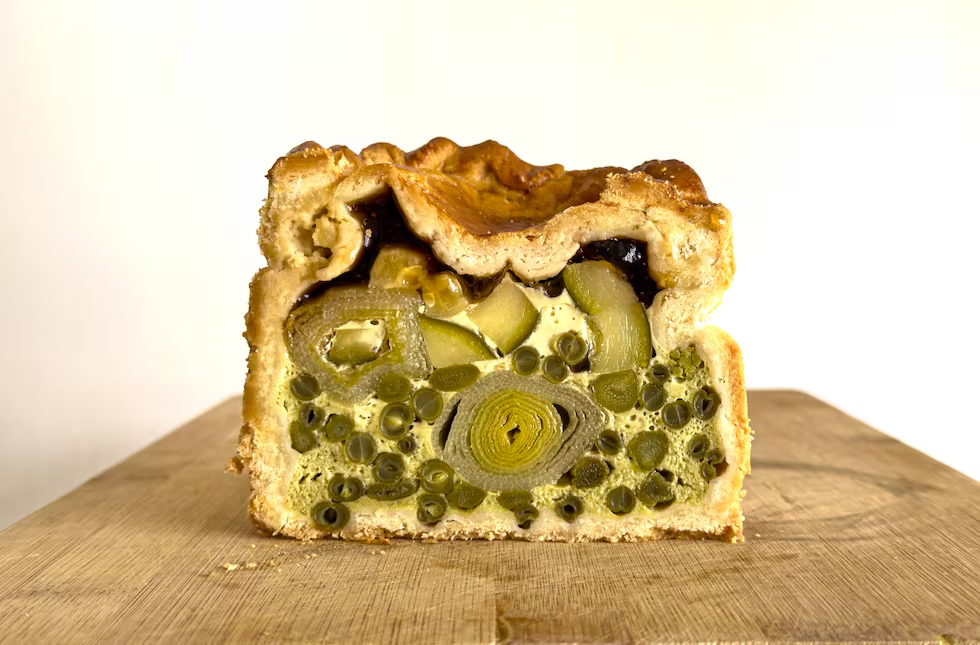
The vegetable version of the French classic requires a little patience and effort but it is not impossible. Follow the step by step instructions: the result is worth it.
I’m not going to start this recipe by saying, “it’s easier than you think.” Making pâté en croûte requires time, patience, and skill. Easy, it is not. But that doesn’t mean you won’t be able to make it perfectly if you follow the steps and measurements precisely. Before we dive into the vegetable version, let’s talk about pâté en croûte: this “pâté in a crust” is a traditional French dish, meaning it has been prepared in local charcuteries with an ancient origin.
As far back as the Middle Ages, these “shells” were made to make use of meat scraps and innards, protecting the food from the outside and preserving it for a longer time. The possibilities are endless: it can contain layers of ground meat from various animals, liver, vegetables… and it’s topped with a gelatin layer that fills the gaps left inside the crust after baking, giving the dish a variety of textures and an attractive appearance.
Building on the basics of the classic recipe – a solid, rigid shortcrust pastry, a compact filling with different textures and colors, and a gelatin layer – I tried making a version with vegetables (though it’s not vegetarian, as it contains animal-derived gelatin). To ensure that the interior would be compact and fill all corners of the mold – something that’s easy to achieve with ground meat and pâté, but not as much with blanched vegetables – I used an egg and milk custard, similar to that of a quiche, which sets in the oven, adding plenty of moisture.
Step by step, the recipe is straightforward. The biggest problem you might encounter is a crack in your dough, leading to leakage in the oven. Be sure to seal all the dough parts together well and place a tray with aluminum foil underneath just in case. The mold is also something to consider: traditional ones are rectangular and come apart on all sides. I used a 26 cm-long mold with a removable base, and it worked great, so that should do the trick.
Difficulty: Medium-high for the lazy. With a bit of patience and care, not so much.
Ingredients
For the pastry:
- 250 g butter
- 5 g sugar
- 10 g salt
- 175 g cornstarch
- 325 g wheat flour
- 1 egg
- 10 ml vinegar
- 90 ml water
For the filling:
- 200 g round green beans
- 2 bunches of green asparagus
- ½ zucchini
- 2 leeks
- 150 g frozen peas
- 4 eggs
- 260 ml milk
- 1 handful of basil leaves
- 100 g goat cheese
- Salt
- Water
- Soy sauce
- 4 gelatin sheets
Instructions
- Pastry Dough: Beat the butter until soft with the salt and sugar for one minute. Mix the egg, water, and vinegar, then add to the butter mixture.
- Mix the flour and cornstarch, and add to the dough in three batches. Once integrated, transfer the dough to a floured surface and knead by hand until it forms a homogeneous ball. Flatten slightly, wrap in plastic wrap, and chill in the fridge for at least one hour.
- Vegetable Prep: Trim the tips of the green beans, the base of the asparagus, and the green part of the leeks. Blanch the green beans and asparagus for 30 seconds and transfer to cold water. Cook the leeks for five minutes and transfer to cold water. Cut the zucchini into sticks.
- Wash the vegetable scraps and simmer them in water for 30 minutes to make a broth. Strain and season with soy sauce until salty.
- Filling: Blend the eggs, milk, peas, and basil for the filling. Strain and season with salt.
- Assemble the Pâté en Croûte: Divide the dough into four parts. On a floured surface, roll out each piece with a rolling pin. One will be the base, two will be the sides, and the last will be the top. Grease the mold with butter and flour. Line the base and sides with dough, leaving about 3 cm of overhang. Make sure the dough joints are well-sealed.
- Layer the vegetables in the mold, one on top of the other, until it is full. Pour the pea and basil custard over the vegetables.
- Place the top layer of dough and seal the edges with the overhanging dough from the sides, crimping the edges to close.
- Poke two holes on top using a piping nozzle and leave the nozzles in place to allow steam to escape.
- Bake at 180ºC for 90 minutes with heat only from below and a fan. If it browns too much, cover with aluminum foil.
- Let the pâté cool for two hours, then refrigerate overnight.
- Gelatin Finish: The next day, heat the vegetable broth and dissolve the hydrated gelatin sheets in it. Pour the broth through the “chimneys” until it overflows. Refrigerate for at least four hours. Slice with a serrated knife and serve cold or warm.
Enjoy!
